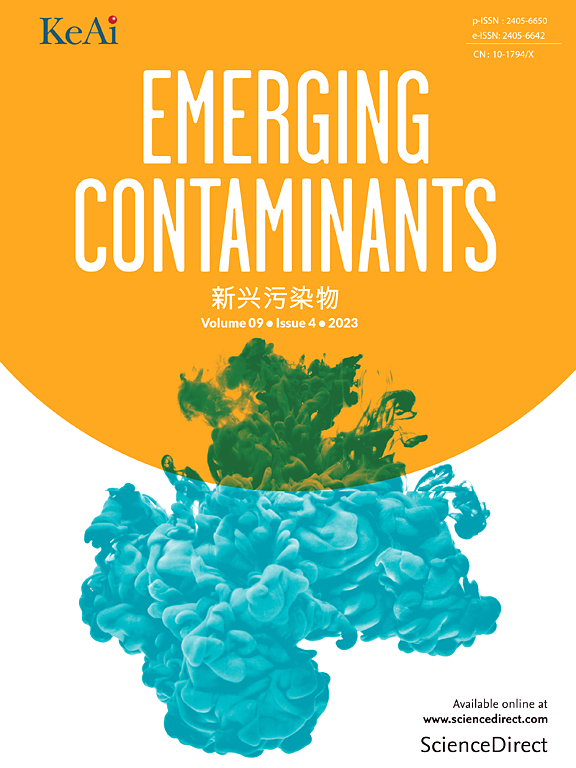Occupational exposure to flame retardants following production replacement and their effect on thyroid function indicators
IF 6.9
2区 环境科学与生态学
Q1 ENVIRONMENTAL SCIENCES
引用次数: 0
Abstract
With the ban of commercial Penta-BDEs, Octa-BDEs, and Deca-BDEs, many manufacturers have been transition to the production of novel brominated flame retardants (NBFRs), organophosphate ester flame retardants (OPFRs), and other alternatives. In this study, we recruited 165 employees with typical occupational exposure from a flame retardants (FRs) production plant in Laizhou Bay, which is the main FRs production area in China, to analyze the internal exposure characteristics of FRs and their potential impacts on thyroid function during the historical production and replacement process. The results showed that the detection frequencies of only triphenyl phosphate (TPHP), BDE-138 and BDE-197 (82.4 %, 61.2 % and 60.6 %, respectively) exceeded 60 % among the 34 compounds of interest, while the median concentrations of BDE-138 and BDE-197 were much higher than TPHP (medians of 103.6, 60.6 and 20.5 ng/g lw, respectively). In addition, the concentrations of these compounds in exposed group are higher than those in the control group (P < 0.05). The correlations among FRs indicated they mainly originated from the production and the debromination process. Overall, these results reflect the changes in the product structure. Free triiodothyronine (fT3) was moderately positively correlated with BDE-138, BDE-197, and TPHP (P < 0.05), and regression analysis further identified BDE-138 as a significant factor influencing fT3 levels. Despite TPHP having a rapid metabolism and short half-life, it was still widely detected in this study, indicating that future research should not only focus on the health risks of BDEs or their degradation products but also consider the health risks associated with TPHP and their mixed exposure, especially given the increasing production of OPFRs as substitutes.
生产更换后阻燃剂的职业性暴露及其对甲状腺功能指标的影响
随着商用五溴二苯醚、八溴二苯醚和十溴二苯醚的禁令,许多制造商已经转向生产新型溴化阻燃剂(NBFRs)、有机磷酸酯阻燃剂(OPFRs)和其他替代品。本研究以中国主要阻燃剂生产区莱州湾某阻燃剂生产厂的165名典型职业暴露员工为研究对象,分析阻燃剂在历史生产和更替过程中的内暴露特征及其对甲状腺功能的潜在影响。结果表明,在34个目标化合物中,只有磷酸三苯酯(TPHP)、BDE-138和BDE-197的检出率(分别为82.4%、61.2%和60.6%)超过60%,而BDE-138和BDE-197的中位数浓度远高于TPHP(中位数分别为103.6、60.6和20.5 ng/g lw)。此外,暴露组中这些化合物的浓度高于对照组(P <;0.05)。FRs的相关性表明,FRs主要来源于生产过程和脱溴过程。总的来说,这些结果反映了产品结构的变化。游离三碘甲状腺原氨酸(fT3)与BDE-138、BDE-197和TPHP中度正相关(P <;0.05),回归分析进一步确定BDE-138是影响fT3水平的显著因素。尽管TPHP代谢快,半衰期短,但在本研究中仍被广泛检测到,这表明未来的研究不仅应关注BDEs或其降解产物的健康风险,还应考虑与TPHP及其混合暴露相关的健康风险,特别是考虑到作为替代品的opfr的产量不断增加。
本文章由计算机程序翻译,如有差异,请以英文原文为准。
求助全文
约1分钟内获得全文
求助全文
来源期刊

Emerging Contaminants
Medicine-Public Health, Environmental and Occupational Health
CiteScore
10.00
自引率
6.70%
发文量
35
审稿时长
44 days
期刊介绍:
Emerging Contaminants is an outlet for world-leading research addressing problems associated with environmental contamination caused by emerging contaminants and their solutions. Emerging contaminants are defined as chemicals that are not currently (or have been only recently) regulated and about which there exist concerns regarding their impact on human or ecological health. Examples of emerging contaminants include disinfection by-products, pharmaceutical and personal care products, persistent organic chemicals, and mercury etc. as well as their degradation products. We encourage papers addressing science that facilitates greater understanding of the nature, extent, and impacts of the presence of emerging contaminants in the environment; technology that exploits original principles to reduce and control their environmental presence; as well as the development, implementation and efficacy of national and international policies to protect human health and the environment from emerging contaminants.
 求助内容:
求助内容: 应助结果提醒方式:
应助结果提醒方式:


